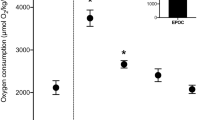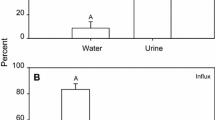Abstract
While it is well known that O2 is directly removed from the water by skin and gill tissues of fish, the mismatch between O2 removal from water (O2 uptake; \(\dot{V}{\text{O}}_{ 2}\)) and the O2 delivered to tissues by the primary circulation (O2 consumption; \(\dot{V}{\text{aO}}_{ 2}\)) has never been measured directly. Using data from four recent studies that simultaneously measured \(\dot{V}{\text{O}}_{ 2}\) and \(\dot{V}{\text{aO}}_{ 2}\) in 2–5 kg Pacific salmon, our analysis revealed that sockeye salmon can remove an additional 12–48 % more O2 from the water than the primary circulation delivers to the systemic tissues. This percentage did not change significantly during swimming activity, a result that contradicts an earlier prediction that the difference should decrease when \(\dot{V}{\text{O}}_{ 2}\) increases during exercise. In resting Chinook salmon, a similar percentage difference in simultaneously measured \(\dot{V}{\text{O}}_{ 2}\) and \(\dot{V}{\text{O}}_{ 2}\) was observed, yet the difference tended to disappear during acute heat stress to a near lethal temperature. These results emphasize that caution should be exercised when using the Fick equation to estimate cardiac output because the overestimate of cardiac output that results from using the Fick equation in Pacific salmon is not small, may not be fixed and may exist in other teleosts.



Similar content being viewed by others
Abbreviations
- CaO2 :
-
Arterial blood O2 content
- CvO2 :
-
Venous blood O2 content
- f H :
-
Heart rate
- T opt :
-
Optimal temperature for aerobic scope
- V s :
-
Cardiac stroke volume
- \(\dot{V}{\text{b}}\) :
-
Cardiac output; rate of blood flow in ventral aorta = f H × V s
- \(\dot{V}{\text{O}}_{ 2}\) :
-
Rate of O2 removal from water by the fish
- \(\dot{V}{\text{aO}}_{ 2}\) :
-
Rate of O2 delivery to tissues by the primary circulation = \(\dot{V}{\text{b}} \times \left( {{\text{CaO}}_{ 2}{\text{-CvO}}_{ 2} } \right)\)
- \(\dot{V}{\text{b-cO}}_{ 2}\) :
-
Rate of branchial-cutaneous O2 removal from water as calculated by \(\dot{V}{\text{O}}_{ 2} - \dot{V}{\text{aO}}_{ 2}\)
- U crit :
-
Critical swimming speed
References
Brett JR (1971) Energetic responses of salmon to temperature. A study of some thermal relations in the physiology and freshwater ecology of sockeye salmon (Oncorhynchus nerka). Am Zool 11:99–113
Cech JJ Jr, Bridges DW, Rowell DM, Balzer PJ (1976) Cardiovascular responses of winter flounder, Pseudopleuronectes americanus (Walbaum), to acute temperature increase. Can J Zool 25:1383–1388
Clark TD, Sandblom E, Cox GK, Hinch SG, Farrell AP (2008) Circulatory limits to oxygen supply during an acute temperature increase in the Chinook salmon (Oncorhynchus tshawytscha). Am J Physiol 295:R1631–R1639
Davis JC (1968) The influence of temperature and activity on certain cardiovascular and respiratory parameters in adult sockeye salmon. MSc dissertation, University of British Columbia
Daxboeck C, Davie PS, Perry SF, Randall DJ (1982) Oxygen uptake in a spontaneously ventilating, blood-perfused trout preparation. J Exp Biol 101:35–45
Eliason EJ, Clark TD, Hague MJ, Hanson LM, Gallagher ZS, Jeffries KM, Gale MK, Patterson DA, Hinch SG, Farrell AP (2011) Differences in thermal tolerance among sockeye salmon populations. Science 332:109–112
Eliason EJ, Clark TD, Hinch SG, Farrell AP (2013a) Cardiorespiratory collapse at high temperature in swimming adult sockeye salmon. Conserv Physiol 1:1–19. doi:10.1093/conphys/cot008
Eliason EJ, Clark TD, Hinch SG, Farrell AP (2013b) Cardiorespiratory performance and blood chemistry during swimming and recovery in three populations of elite swimmers: adult sockeye salmon. Comp Biochem Physiol A 166:385–397
Farrell AP (1991) From hagfish to tuna: a perspective on cardiac function in fish. Physiol Zool 64:1137–1164
Farrell AP (2009) Environment, antecedents and climate change: lessons from the study of temperature physiology and river migration of salmonids. J Exp Biol 212:3771–3780
Farrell AP, Steffensen JF (1987) An analysis of the energetic cost of the branchial and cardiac pumps during sustained swimming in trout. Fish Physiol Biochem 4:73–79
Farrell AP, Lee CG, Tierney K, Hodaly A, Clutterham S, Healey M, Hinch S, Lotto A (2003) Field-based measurements of oxygen uptake and swimming performance with adult Pacific salmon using a mobile respirometer swim tunnel. J Fish Biol 62:64–84
Farrell AP, Hinch SG, Cooke SJ, Patterson DA, Crossin GT, Lapointe M, Mathes MT (2008) Pacific salmon in hot water: applying aerobic scope models and biotelemetry to predict the success of spawning migrations. Physiol Biochem Zool 82:697–708
Farrell AP, Eliason EJ, Sandblom E, Clark TD (2009) Fish cardiorespiratory physiology in an era of climate change. Can J Zool 87:835–851
Garey W (1970) Cardiac output of the carp (Cyprinus carpio). Comp Biochem Physiol 33:181–189
Glover CN, Bucking C, Wood CM (2013) The skin of fish as a transport epithelium: a review. J Comp Physiol B 183:877–891
Huang Z-H, Ma A-J, Wang X-A (2011) The immune response of turbot, Scophthalmus maximus (L.), skin to high water temperature. J Fish Dis 34:619–627
Hughes GM, Peyraud C, Peyraud-Waitzenegger M, Soulier P (1982) Physiological evidence for the occurrence of pathways shunting blood away from the secondary lamellae of eel gills. J Exp Biol 98:277–288
Ishimatsu A, Iwama GK, Heisler N (1988) In vivo analysis of partitioning of cardiac output between systemic and central venous circuits in rainbow trout: a new approach using chronic cannulation of the branchial artery. J Exp Biol 137:75–88
Jain KE, Hamilton JC, Farrell AP (1997) Use of a ramp velocity test to measure critical swimming speed in rainbow trout, Oncorhynchus mykiss. Comp Biochem Physiol A 117:441–444
Jain KE, Birtwell IK, Farrell AP (1998) Repeat swimming performance of mature sockeye salmon following a brief recovery period: a proposed measure of fish health and water quality. Can J Zool 76:1488–1496
Kiceniuk JW, Jones DR (1977) The oxygen transport system in trout (Salmo gairdneri) during sustained exercise. J Exp Biol 69:247–260
Kirsch R, Nonnotte G (1977) Cutaneous respiration in three fresh-water teleosts. Respir Physiol 29:339–354
Krogh A (1904) Some experiments on the cutaneous respiration of vertebrate animals. Scand Arch Physiol 16:348–357
Lee CG, Farrell AP, Lotto A, MacNutt MJ, Hinch SG, Healey MC (2003) The effect of temperature on swimming performance and oxygen consumption in adult sockeye (Oncorhynchus nerka) and coho (O. kisutch) salmon stocks. J Exp Biol 206:3239–3251
Nonnette G (1981) Cutaneous respiration in six freshwater teleosts. Comp Biochem Physiol 70A:541–543
Nonnette G, Kirsch R (1978) Cutaneous respiration in seven seawater teleosts. Respir Physiol 35:101–119
Olson KR (1984) Distribution of flow and plasma skimming in isolated perfused gills of three teleosts. J Exp Biol 109:97–108
Randall DJ (1985) Shunts in fish gills. In: Johansen K, Burggren WW (eds) Cardiovascular shunts., Alfred benzon symposium 21Munksgaard, Copenhagen, pp 71–87
Randall DJ, Holeton GF, Stevens ED (1967) The exchange of oxygen and carbon dioxide across the gills of rainbow trout. J Exp Biol 46:339–348
Rasmussen KJ, Steffensen JF, Buchmann K (2013) Differential occurrence of immune cells in the primary and secondary vascular system in rainbow trout, Oncorhynchus mykiss (Walbaum). J Fish Dis 36:675–679
Richter A, Kolmes SA (2005) Maximum temperature limits for chinook, coho, and chum salmon, and steelhead trout in the Pacific Northwest. Rev Fish Sci 13:23–49
Rombough PJ (1988) Respiratory gas exchange, aerobic metabolism, and effects of hypoxia during early life. In: Hoar WS, Randall DJ (eds) The physiology of developing fishes, fish physiology, vol 11A. Academic Press, San Diego, pp 185–218
Rombough PJ, Ure D (1991) Partitioning of oxygen uptake between cutaneous and branchial surfaces in larval and young juvenile chinook salmon Oncorhynchus tshawytscha. Physiol Zool 64:717–727
Rummer JL, Wang S, Steffensen JF, Randall DJ (2014) Function and control of the fish secondary vascular system: a contrast to mammalian lymphatic systems. J Exp Biol 217:751–757
Satchell GH (1991) Physiology and form of fish circulation. Cambridge University Press, Cambridge, p 235
Soivio A, Nikinnma M, Nyholm K, Westman K (1981) The role of gills in the responses of Salmo gairdneri during moderate hypoxia. Comp Biochem Physiol 70A:133–139
Steffensen JF (1985) The transition between branchial pumping and ram ventilation in fishes: energetic consequences and dependence on water oxygen tension. J Exp Biol 144:141–150
Steffensen JF, Lomholt JP (1985) Cutaneous oxygen uptake and its relationship to skin blood perfusion and ambient salinity in the plaice, Pleuronectes platessa. Comp Biochem Physiol 81A:373–375
Steffensen JF, Lomholt JP (1992) The secondary vascular system. In: Hoar WS, Randall DJ, Farrell AP (eds) The cardiovascular system, fish physiology, vol 12A. Academic Press, San Diego, pp 185–218
Steffensen JF, Lomholt JP, Johansen K (1981) The relative importance of skin oxygen uptake in the naturally buried plaice, Pleuronectes platessa, exposed to graded hypoxia. Respir Physiol 44:269–275
Steffensen JF, Lomholt JP, Vogel WOP (1986) In vivo observations on a specialized microvasculature, the primary and secondary vessels in fishes. Acta Zool Stockh 67:193–200
Steinhausen MF, Sandblom E, Eliason EJ, Verhille C, Farrell AP (2008) The effect of acute temperature increases on the cardiorespiratory performance of resting and swimming sockeye salmon (Oncorhynchus nerka). J Exp Biol 211:3915–3926
Thorarensen H, Gallaugher PE, Farrell AP (1996) The limitations of heart rate as a predictor of metabolic rate in fish. J Fish Biol 49:226–236
Tucker VA (1967) Method for oxygen content and dissociation curves on microliter blood samples. J Appl Physiol 23:410–414
Vogel WOP (1985) Systemic vascular anastomoses, primary and secondary vessels in fish, and the phylogeny of lymphatics. In: Johansen K, Burggren WW (eds) Cardiovascular Shunts., Alfred Benzon Symposium 21Munksgaard, Copenhagen, pp 143–159
Wagner GN, Kuchel LJ, Lotto A, Patterson DA, Shrimpton JM, Hinch SG, Farrell AP (2006) Routine and active metabolic rates of migrating adult wild sockeye salmon (Oncorhynchus nerka Walbaum) in seawater and freshwater. Physiol Biochem Zool 79:100–108
Acknowledgments
MFS was supported by The Carlsberg Foundation. TDC was supported by a Killam Postdoctoral Fellowship and the Natural Sciences and Engineering Research Council of Canada (NSERC). EJE and APF were supported by NSERC. APF holds a Canada Research Chair.
Author information
Authors and Affiliations
Corresponding author
Additional information
Communicated by I.D. Hume.
Rights and permissions
About this article
Cite this article
Farrell, A.P., Eliason, E.J., Clark, T.D. et al. Oxygen removal from water versus arterial oxygen delivery: calibrating the Fick equation in Pacific salmon. J Comp Physiol B 184, 855–864 (2014). https://doi.org/10.1007/s00360-014-0839-7
Received:
Revised:
Accepted:
Published:
Issue Date:
DOI: https://doi.org/10.1007/s00360-014-0839-7




